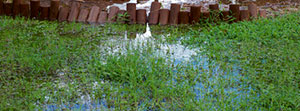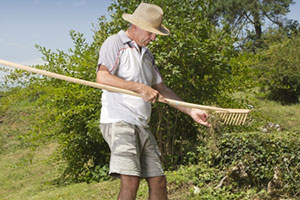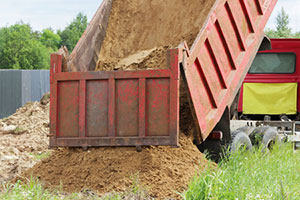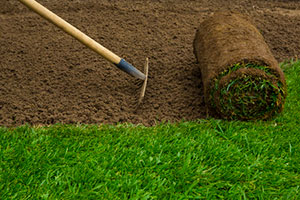 Ensuring that your yard is properly drained is one of the best ways to practice good lawn care. No homeowner wants to deal with the nightmare of a soggy flooded yard or eroded soil. In the event of a huge storm, water could flood your house and put you and your family at risk. In order to avoid disaster you should consider grading dirt in your yard so it can drain properly. If you’re up for the task, you can tackle a grading project yourself to prevent future water problems. In this blog, I’ll tell you why it is important to grade your yard and give you the steps to complete a successful grading project.
Ensuring that your yard is properly drained is one of the best ways to practice good lawn care. No homeowner wants to deal with the nightmare of a soggy flooded yard or eroded soil. In the event of a huge storm, water could flood your house and put you and your family at risk. In order to avoid disaster you should consider grading dirt in your yard so it can drain properly. If you’re up for the task, you can tackle a grading project yourself to prevent future water problems. In this blog, I’ll tell you why it is important to grade your yard and give you the steps to complete a successful grading project.
Why Grade Your Yard?
One big thing that homeowners overlook when it comes to their yard is how it is sloped. The slope of your lawn is critical to its health and your home’s safety. If your yard isn’t properly graded, storm or irrigation water can cause damage to your home’s foundation and the soil around it. Grading your yard with fill dirt as soon as possible will save you time, money, and headaches from cracks and damage in the foundation and potential soil erosion.
What’s even worse? A down-sloped or improperly graded yard can not only ruin your home, but ruin your neighbors’ homes also. Rain and snowmelt in the winter months can erode and flood your neighbors’ homes and can leave you stuck with the bill. Avoid these mistakes at all costs by grading dirt in your yard as soon as possible.
Prepping Your Grading Project
 Before you begin your grading project, make sure to prepare the project area. This means checking to make sure that there are no obstacles in your yard that would impede your grading project and cause you mistakes. Pay careful attention to spot any snags like pipes that stick out of your house or the ground.
Before you begin your grading project, make sure to prepare the project area. This means checking to make sure that there are no obstacles in your yard that would impede your grading project and cause you mistakes. Pay careful attention to spot any snags like pipes that stick out of your house or the ground.
If you overlook a drainage pipe or drainage trap and start grading, you could potentially cover them up with fill dirt and destroy any of the progress you begin to make with your grading project. If there are any pipes or traps that pop up out of the ground, make sure you find extensions to hook onto them before you begin grading so they can stay above ground once you finish. You don’t want to be stuck in the middle of your project and have to shovel off all the grading dirt to get to the pipe you forgot to cover. Preparing beforehand will save you time, money and frustration.
How To Grade Your Yard
If you’re new to yard grading and grading dirt, it may sound like a complicated and frustrating job, but it’s really rather simple. There are 5 easy steps to success:
1. Finding the Slope
To find the slope, you will need to use two wooden stakes, a foot-long string, hammer, tape measure, and a line level.
- Hammer a stake into the ground right next to the foundation
- Tie the string around the stake
- Use the tape measure to measure 10 feet from the home foundation and hammer in a second stake
- Tighten the other end of the string around the second stake
- Fasten the line level to the center of the string
- Make sure the string is level by sliding it up or down the second stake
- Find the slope by measuring the distance between the string on the second outer stake to the ground
2. Order Your Fill Dirt
 Finding the right fill dirt for your grading project is extremely important. You don’t want the wrong type of soil or even a delivery of contaminated and dangerous soil that could ruin your yard and endanger you and your family’s health and safety. Uncertified grading dirt can come laced with shards of glass or toxic chemicals and could make your yard worse off than when you started. You also want to make sure to get the right amount for your grading project, so determine the size of the project first, then find a reputable company that can provide you with the best clean grading dirt delivered straight to your house to get the job done more easily.
Finding the right fill dirt for your grading project is extremely important. You don’t want the wrong type of soil or even a delivery of contaminated and dangerous soil that could ruin your yard and endanger you and your family’s health and safety. Uncertified grading dirt can come laced with shards of glass or toxic chemicals and could make your yard worse off than when you started. You also want to make sure to get the right amount for your grading project, so determine the size of the project first, then find a reputable company that can provide you with the best clean grading dirt delivered straight to your house to get the job done more easily.
3. Finding the High and Low Points of Your Yard
These two points are the most vulnerable parts of your yard. The high point of your yard is where its slope is at its peak. The water in your yard starts draining the wrong way towards your house at this point. The low point is the point at which the water ends up.
4. Dump, Rake, and Pack the Dirt
Using a wheelbarrow, start by dumping the pile of dirt at the low point of your project. For instance, if your low point is at the foot of your home’s foundation and water is draining towards your house, you want to have a huge pile of dirt as a starting point for regrading your yard. The amount of dirt you use should be enough to make the low point level out to the high point. Then add more dirt to correct the grade so that your original low point is now the high point.
 Now to change the angle of slope, use the back of a rake to smooth out the dirt from your new high point (what was once the problem area) by raking it towards your new low point (what was once the area where water flowed from). Finally, pack the dirt down so it is consistent and even. You can use a piece of plywood and jump on it or use a tamper to do the job.
Now to change the angle of slope, use the back of a rake to smooth out the dirt from your new high point (what was once the problem area) by raking it towards your new low point (what was once the area where water flowed from). Finally, pack the dirt down so it is consistent and even. You can use a piece of plywood and jump on it or use a tamper to do the job.
5. Plant New Grass
Now that you have a new slope and newly graded yard, it’s time to finish the project by planting grass to make it a masterpiece! Here are some simple steps to plant grass seed:
- Toss a whole bunch of grass seed over the newly graded dirt
- Use a rake to spread the the seeds and let them settle into the dirt
- Water all the seeds thoroughly
- Cover up the seeds with either yard clippings or hay. This hides the seeds from being eaten by birds and helps them to retain moisture
- Water the area again, as grass seed needs plenty of water to grow
- Water the area every day; in about a week you will see grass start to grow
Contrary to what many homeowners may think, the process of regrading your yard for proper drainage is a lot easier if you break it down into the stages I just outlined above. It’s simply just finding the high and low points of your yard and reversing them using quality fill dirt and some other simple tools. If you’re a DIY homeowner who’s up for some hard work, you can probably knock out a regrading project yourself in a weekend, or maybe even a few hours. However, if you’re hesitant about doing it all yourself on the first try, give a reputable residential dirt grading contractor a call. They have years of experience needed to get the job done the right way on time.









































